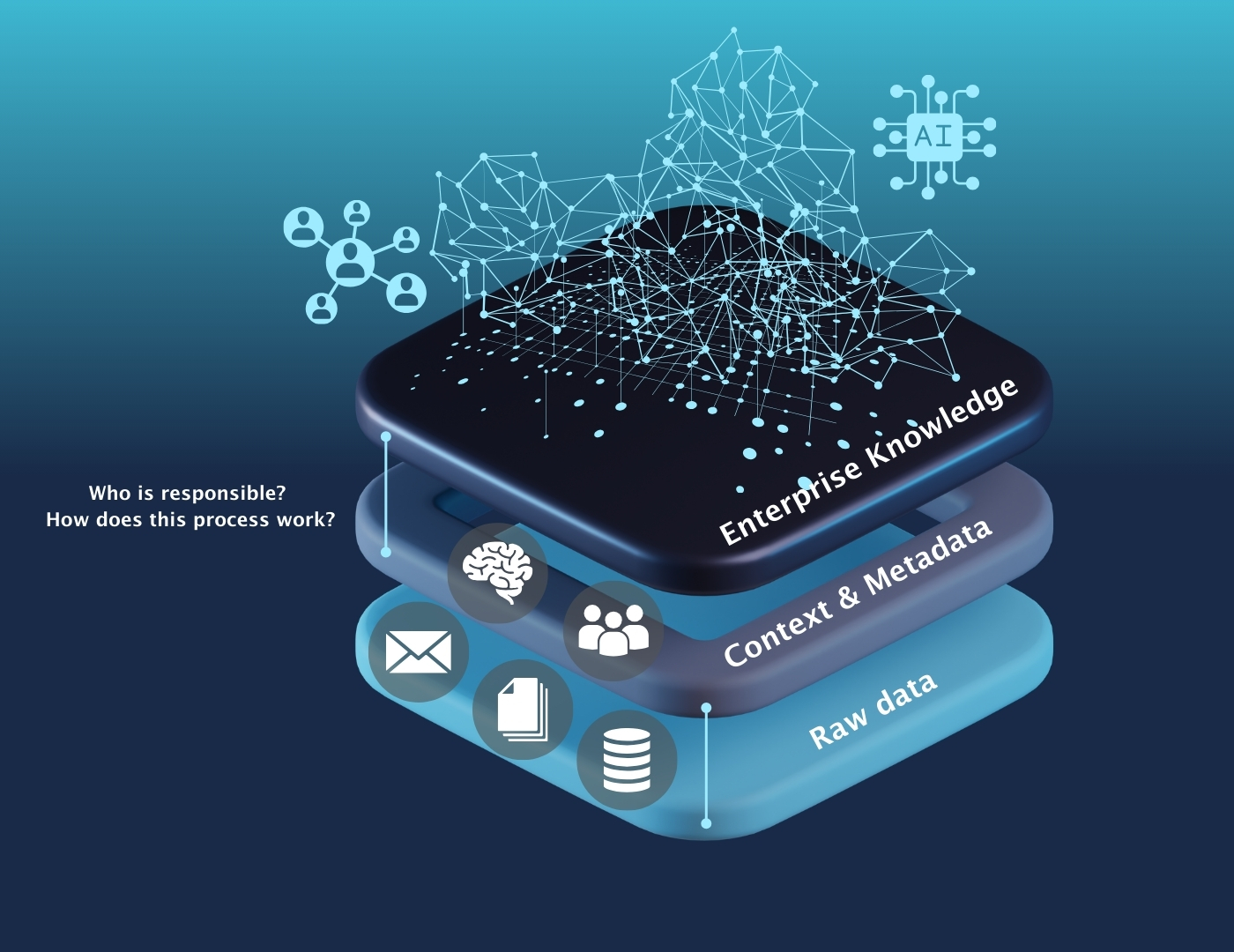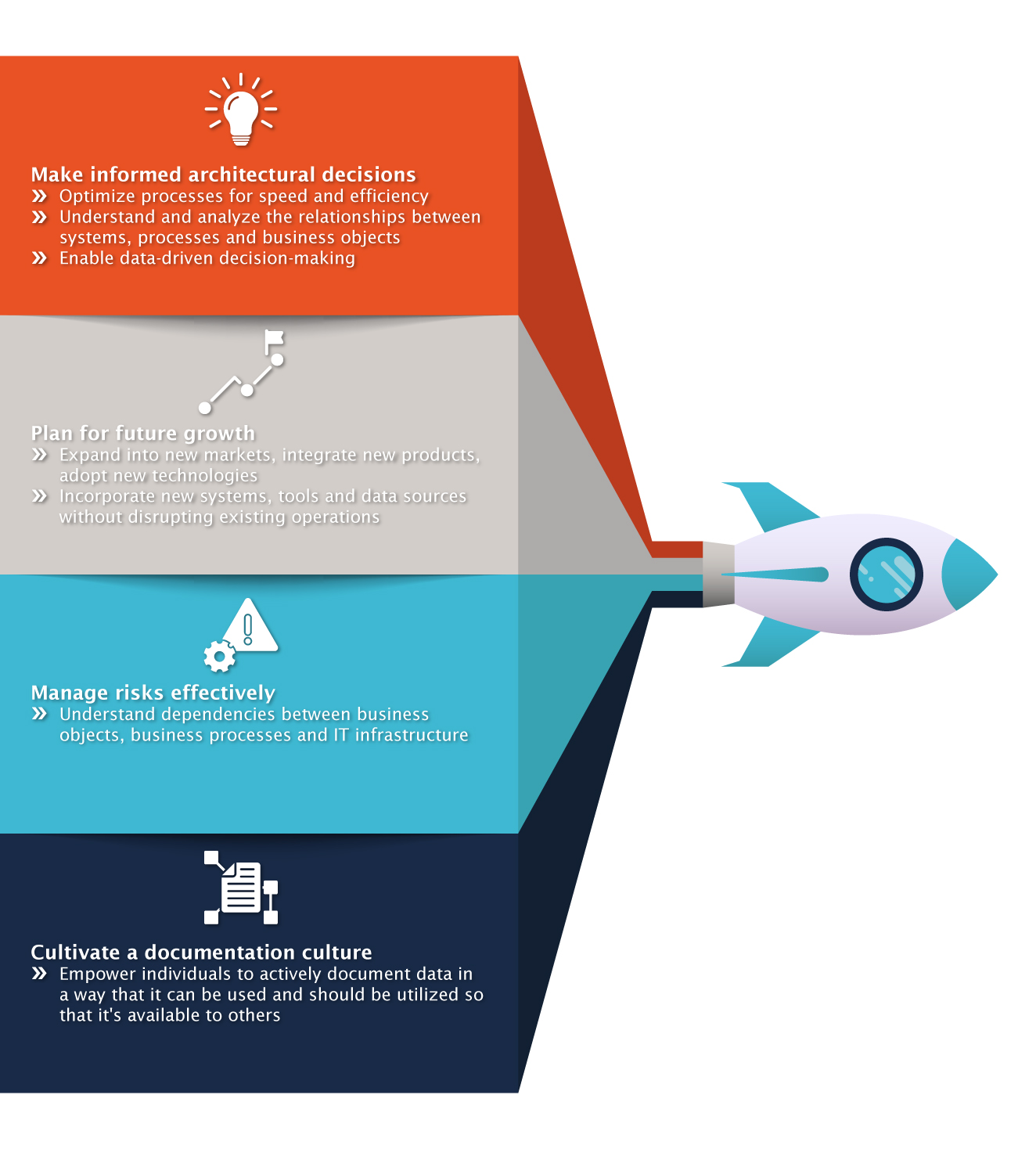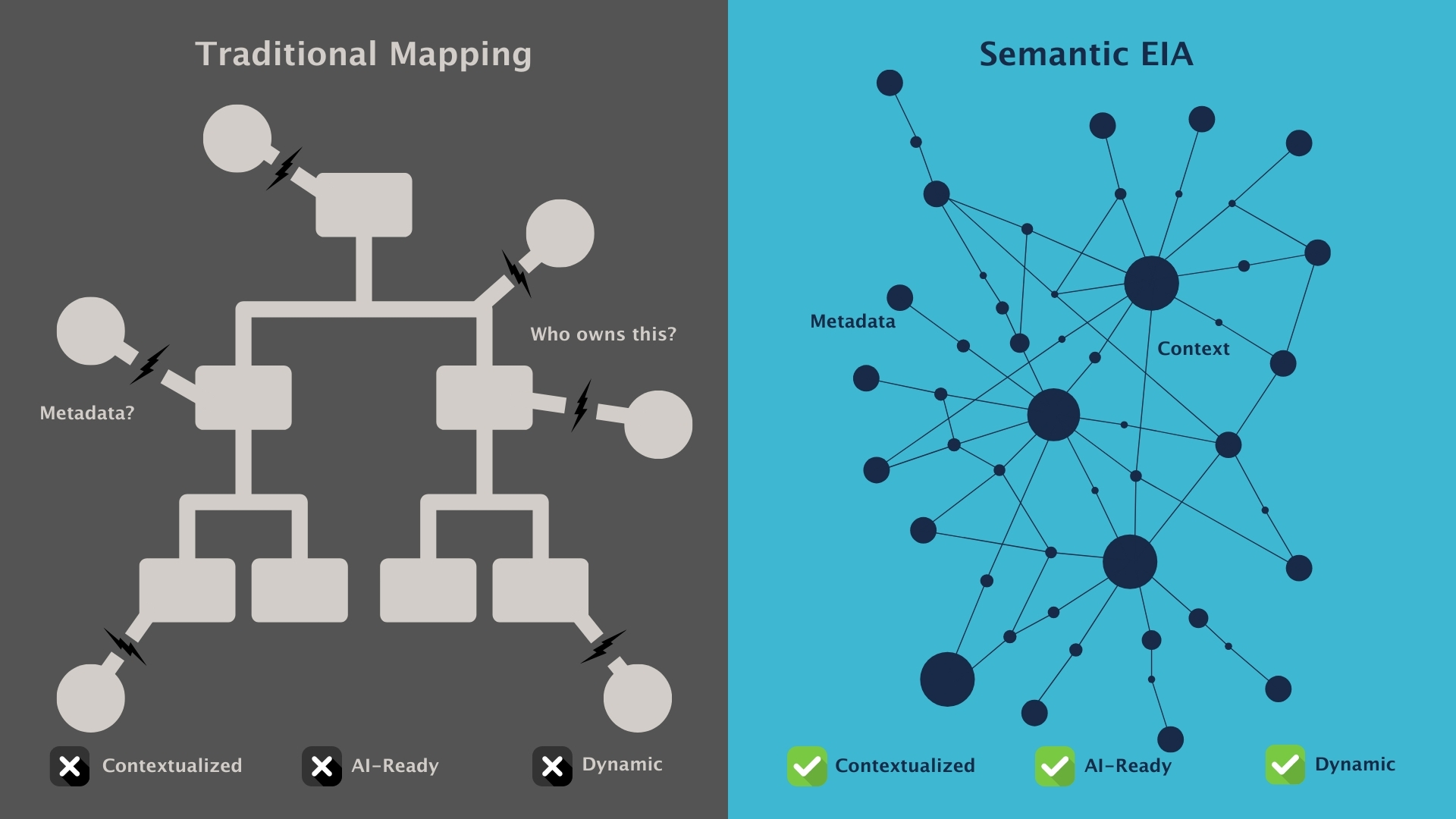Why are businesses adopting a semantics-based Enterprise Information Architecture (EIA) and what is it exactly? Discover what an EIA is, how it differs from existing data documentation efforts and what business goals can accomplish with a semantics-based EIA.
Everything you need to know about Enterprise Information Architecture
Table of contents:
-
How do semantic knowledge models complement Enterprise Information Architecture?
-
What challenges does an Enterprise Information Architecture address?
-
What benefits does Enterprise Information Architecture offer?
-
Why choose an Enterprise Information Architecture over existing data documentation efforts?
What is Enterprise Information Architecture?
Have you heard of ‘Enterprise Information Architecture (EIA)’? It can easily be confused with well-established terms such as ‘information architecture’ and ‘enterprise architecture’, which are long used in many large organizations.
Information architecture refers to an organization’s IT landscape and how it organizes and stores data, while enterprise architecture maps business processes and uses it to transform and optimize the way the business operates.
An Enterprise Information Architecture combines both elements of information architecture and enterprise architecture to describe the documentation of data and metadata about enterprise systems, processes and information landscape based on a semantic knowledge model.
The core difference distinguishing Enterprise Information Architecture from these other concepts is the semantic knowledge model underlying the EIA. It connects business and IT by mapping data and meta-data about the enterprise—including business processes or organization-specific terms and concepts and existing IT systems—in an interoperable and human and machine-interpretable format.
Beyond simply capturing (meta-)data, a semantic-driven EIA offers a bird’s eye view of all existing systems and processes, and focuses on capturing context that describes what the data is about, how it connects to the enterprise processes and its IT systems, why they are used and who is responsible for them.

Image: Raw data + Context & Metadata + Enterprise Knowledge makeup an EIA
How do semantic knowledge models complement Enterprise Information Architecture?
In the context of an EIA, a semantic knowledge model explicitly describes granular details about enterprise systems, processes, and the inputs and outputs of business processes (all referred to as ‘Business Objects’ in an EIA) that exist in the organization, as well as describing information such as how they work, who is responsible for these activities (AKA enterprise metadata).
Metadata about Business Objects is the nuance that may only be known in experts' minds or documented in emails and files, which can add immense value and insight about company operations. It provides the basis for decision-making grounded in expert knowledge and meaningful context so that decisions are not only based on data but true knowledge.
The result is a data environment that is connected, contextualized and rich in information, and a new data culture where data documentation becomes a discipline everyone takes part in.
With an EIA, data is no longer purely an IT responsibility or an external activity, but something the whole organization contributes to and collaborates on. And a broadened understanding of data is the foundation for enabling a very AI-savvy organization.
What challenges does an Enterprise Information Architecture address?
Enterprise information architecture isn’t new to many organizations–but an EIA based on a semantic model is the innovative approach modern enterprises are seeking to address long-standing data challenges, drive new business opportunities and improve the efficiency of global operations.
Mainly, an EIA helps to solve these significant data challenges global enterprises are facing today:
Siloed systems
Most large organizations use numerous systems and applications to manage all sorts of information, such as CRMs, ERPs, for example. And on top of that, use different tools to document what these systems are in multiple applications and tools that are independent of each other, quickly resulting in silos.
Bridging the semantic gap
Each department and team has its own set of terminology to describe a particular object, function or process in conversation, systems and applications. The variation in terms often leads to miscommunications and inconsistencies. Creating a consistent, shared understanding of the meaning of data by getting alignment on BOs across all departments eliminates ambiguity, making it easy for everyone to understand and use the correct terms in all communications and systems.
Bridging between the physical layer and Business Objects
What exists in the physical world, like data storage facilities and product parts, should also be documented digitally and be properly linked to existing data systems. Existing approaches are either too IT-focused or too business-focused and fail to connect information captured by these two groups.
Fragmented documentation
On the IT side, documentation such as data catalogs captures only a technical view of systems, often failing to incorporate the business language defined in a business glossary. Conversely, business documentation is typically created using business process modeling or information modeling tools, which have several limitations:
-
Static and inflexible – Once created, they are difficult to extend.
-
Disconnected – Even when overlaps exist, these diagrams often lack meaningful relationships to one another.
-
Lack semantics – Without clearly defined interpretations, ambiguity arises, leading to inconsistent understanding by both humans and AI applications.
-
Uninterpretable – The absence of structured semantics makes these models difficult for both humans and machines to process effectively.
Lastly, metadata is often captured in even less structured forms, like Wiki pages. All of which make it near impossible to keep up with and maintain documentation of all existing systems and processes.
Easily find answers to questions about enterprise systems and operations
Finding answers to questions about your enterprise operations, such as “How will a new CRM system in the US impact invoicing?” or “What IT changes are needed for business process modifications?” typically involve aggregating data from multiple sources, and is often difficult to know where to even begin.
What benefits does Enterprise Information Architecture offer?

Image: Benefits of an Enterprise Information Architecture
The core business goal organizations achieve by implementing an EIA is becoming data-driven and AI-ready. By being able to understand the relationships and context around your Business Objects, you can leverage all the data your organization holds and make it accessible to all employees, making it possible for AI agents and systems to complement this data. This convergence primarily supports and assists all business users in the organization in their daily work and decision-making, and also offers the potential for automating tasks.
More specifically, a semantics-based EIA supports a number of business priorities such as:
-
Make informed architectural decisions
-
Optimize processes for speed and efficiency
-
Understand and analyze the relationships between systems, processes and business objects
-
Enable data-driven decision-making
-
-
Plan for future growth
-
Expand into new markets, integrate new products, adopt new technologies
-
Incorporate new systems, tools and data sources without disrupting existing operations
-
-
Manage risks effectively
-
Understand dependencies between business objects, business processes and IT infrastructure
-
-
Cultivate a documentation culture
-
Empower individuals to actively document data in a way that it can be used and should be utilized so that it's available to others
-
Why choose an Enterprise Information Architecture over existing data documentation efforts?

Image: Traditional methods of documentation vs. an Enterprise Information Architecture
As we mentioned before, documentation is a core aspect of Enterprise Information Architecture, and traditional methods of mapping enterprise information architecture rely on inflexible diagrams and documents that fail to include crucial metadata and context that is valuable for decision-making.
A semantics-based EIA transforms traditional mapping by integrating existing assets through a semantic model, unifying relevant metadata in context. This goes far beyond what Wikis or existing systems can achieve, providing a dynamic, interconnected map of the organization.
How does AI support Enterprise Information Architecture?
You will need tooling to create your Enterprise Information Architecture and technologies like AI and knowledge graphs can provide the foundation. An EIA offers to bring together metadata from many different sources so it can be centrally combined and stored in an interconnected enterprise architecture, and knowledge graph technology is ideal for capturing that data. It allows you to connect information, lineage and provenance data from the original systems while simultaneously enriching it with context and connections between all of the data and information in these systems.
With the knowledge graph serving as the ideal platform for storing and querying information—allowing access from all possible angles—you also need a way for business users to interact with the system easily. A conversational interface that uses a semantic model to detect user intent is the perfect solution, enabling users to ask questions without needing to understand the underlying knowledge graph technology or how data and metadata are structured within the Enterprise Information Architecture. Since this information is already captured in business objects and the architecture itself, users can simply query the system in their own language.
This allows users to query the system from their own perspective while also enabling more technical queries when needed. Additionally, AI plays a crucial role in supporting users throughout the modeling process—suggesting mappings, reviewing models, and helping them create the optimal representation of their data within the enterprise architecture.
Read next:


















